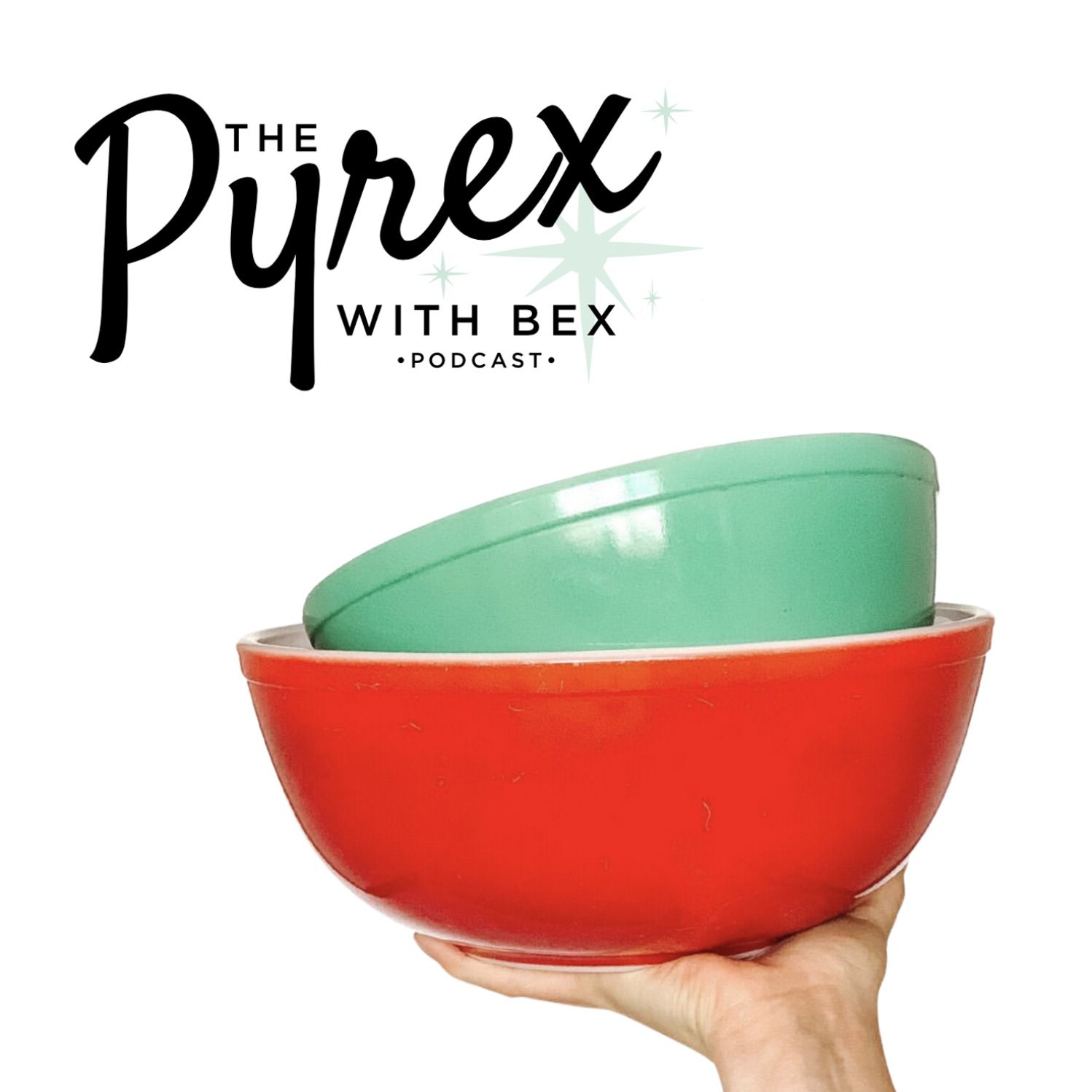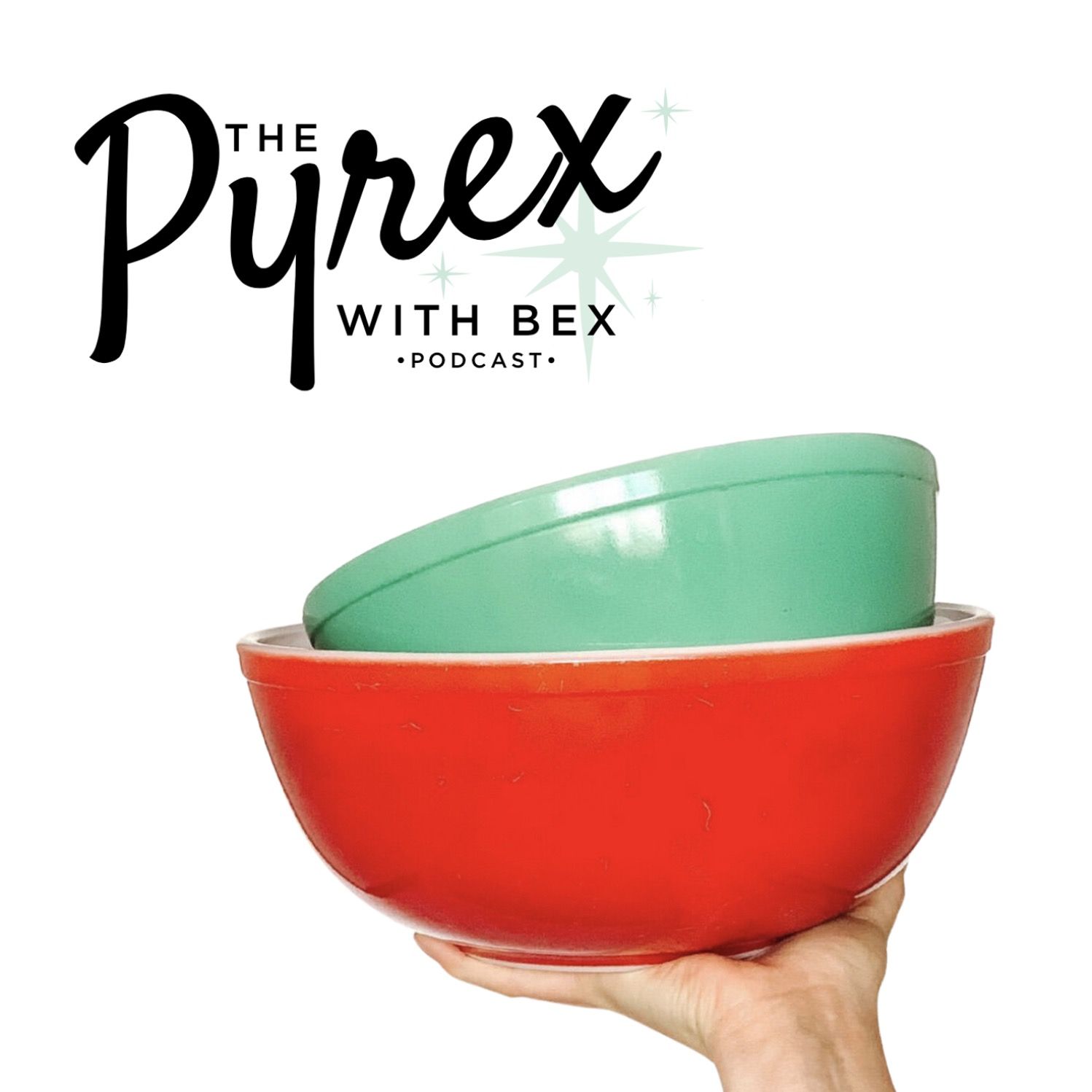Federal Glass & More with Ruth from Periwinkle Collectibles
Description
Bex Scott welcomes guest Ruth from Periwinkle Collectibles on Instagram to the show to talk all about Federal Glass, among other things. Ruth teaches Bex some fascinating facts about Federal Glass, their patterns, which country they released certain items in, and how to spot the collectibles in the wild. Not every thrift trip can be single-minded, however, so Bex and Ruth talk about some of the other vintage items they search for and enjoy as well.
Ruth claims Pyrex collecting was her gateway into other milk glass companies, patterns, and makers, and admits that in the early days, she would find something she thought was Pyrex only to bring it home and learn it wasn’t. Through those research lessons, she found that something she initially thought was Fire King was in fact Federal Glass and that sent her on a whole new collecting journey. Bex learns about the sheer number of varieties of dot colors and sets available in Federal Glass, how so many promotional items came to be made of Federal Glass, and how to differentiate Federal from other items in the wild. Join this episode to learn what Facebook Group to join for identifying Federal, what pieces are most sought-after, and exactly how many collections Ruth draws the line at maintaining.
Resources discussed in this episode:
- Vintage Federal Glass Facebook Group
- Early American Pattern Glass Society: Federal Glass vintage patterns reference
- “Shield F - The Mark of Quality” by Marg Iwen, Winter 2006, The Federation of Historical Bottle Collectors
- Federal Glass circus bowls
- Federal Glass dots bowls
- Federal Glass mushroom bowl
- 1974 Federal Glass ad page
—
Contact Ruth | Periwinkle Collectibles
- Instagram: @periwinklecollectibles
Contact Rebecca Scott | Pyrex With Bex:
—
Transcript
Bex Scott: [00:00:02 ] Hey everybody, it's Bex Scott and welcome to the Pyrex with Bex podcast where, you guessed it, I talk about vintage Pyrex, but also all things vintage housewares. I'll take you on my latest thrifting adventures, talk about reselling, chat with other enthusiasts about their collections, and learn about a bunch of really awesome items from the past. Subscribe now on Apple, Spotify, or wherever you love listening to podcasts so you don't miss a beat. Hey everybody, this is Bex Scott and you are listening to the Pyrex with Bex podcast. And today I am very excited to have Ruth from Periwinkle Collectibles. Welcome back Ruth.
Ruth: [00:00:41 ] Hi Bex, it's good to be back.
Bex Scott: [00:00:44 ] How have you been since we last talked?
Ruth: [00:00:46 ] Oh, it's been a great, wonderful summer. But the days are getting shorter, the leaves are starting to fall, and it's time to start thinking about collections, isn't it?
Bex Scott: [00:00:57 ] It is. And my favorite Halloween fall season for Pyrex displays is just around the corner and I, as everybody knows, am an avid Pyrex collector. You collect Pyrex yourself, but today I'm very excited because you are going to talk to us about a different collection that you have. So maybe just kick us off and let us know what you're going to be chatting about.
Ruth: [00:01:23 ] Sure, sure. I thought that Pyrex, at least for me, was a gateway into a lot of other milk glass companies and patterns and makers, and many of us have found something at the thrift, found something out in the wild, brought it home thinking it was Pyrex. Started doing a little bit of research. And for me, this was before Google Image and before AI put all kinds of weird things out there, but it was before Google Image, so you'd have to try and describe what you had found to figure out, well, this isn't Pyrex, because it takes a while to realize that most Pyrex pieces have Pyrex stamped on them. And so you find a pretty white bowl at the thrift store with a really cute pattern, or what you think is really cute. And I mean, now I just, I flip things over and look for the maker mark. But back then I would just go oh 2.99 and this is pretty, in the cart it goes, and I'd bring it home and I'd go, oh, I found this great Pyrex. And then I'd start looking at it and trying to figure out the pattern and oh my gosh, I realized it wasn't Pyrex. Well, then what the heck was it? Well, I found quite a few pieces that had a really large capital F in a shield and I thought, wow, I found Fire-King! And I went on, this is the days of Facebook groups being the only place to really share things.
Ruth: [00:02:51 ] This is kind of early days of Instagram and before a lot of other social media. I remember going onto a Fire-King group and excitedly sharing what I had found. And wow, I got politely but quickly schooled that what I had found was not Fire-King, but it was Federal. And I'm like Federal? What the heck is that? So I started looking up the patterns of that and going, oh. So I mean, Federal Glass was a company that was around for, I think, around 80-ish years in the States. I think they were in Ohio. They started off making, I think it was like pressed glass in the early 1900s. They made an awful lot of depression glass. And I'll be honest, even though I lived through the 80s and 90s, I have never collected depression glass in my life. A lot of my friends were collecting depression glass during that time, but I never really got into it. It didn't, it didn't appeal to me because depression glass, that's a whole nother discussion. But Federal made a lot of depression glass. They made a lot of barware. But what I particularly really enjoy is the opal ware or the, what people call milk glass, and the pretty patterns that I thought were made by Federal. Because when I flipped the bowl or the casserole or the mug over, it had an F and a shield. But I also discovered that, well, Federal made an awful lot of milk glass or opal ware, they also sold what was called blanks to decorator companies. And so I live in Canada, and what I have learned over the years is that in particular, there was a company outside of Toronto that did a lot of decorating of Federal blanks and other Fire-King and a few other blanks too, and they were called Cutler. C U T L E R. So they, like, printed on Federal blanks. And that's kind of the main reason why the Federal glass that's found in Canada, it's a lot of different patterns. I mean, there is some overlap, but there's quite a lot of patterns that are more commonly found in Canada than in the States.
Bex Scott: [00:05:19 ] Interesting. I am already learning things from you because I had no idea. I had heard of Cutler and I'd heard of Federal Glass, but that is very cool.
Ruth: [00:05:29 ] Yeah, I mean Cutler, they bought blanks from other companies and they did a lot of glassware. But basically their thing was they decorated glassware. You know, they painted onto items made by other companies. So there's a lot of Federal Glass in Canada that is tourist ware, you know, mugs with city, city and town names on them and festivals and hockey teams and businesses and things like that. And of course, it exists in the States also, and Federal in the states was also making decorated milk glass and other glass items. But it explains why some patterns show up in Canada in way larger quantities. There was a gas company in Quebec, I believe it was, that gave away the circus bowls. That's a pattern that a lot of Federal collectors, or you've probably seen it too, it has like red, orange, green, blue pattern around the edge of various circus animals and circus carts and things. Well, that was a giveaway from a gas station in Quebec.
Bex Scott: [00:06:41 ] No way.
Ruth: [00:06:43 ] Yes way.
Bex Scott: [00:06:44 ] I would love to get that from a gas station. Why can't we get that from gas stations now?
Ruth: [00:06:48 ] I know. When I could, when I could afford gas in the 80s, it was Petro Can. And all we got was those ugly glasses that said every garage sale you ever go to in Canada. But this was an earlier time because I think Federal Glass was out of business by 1980, for sure. I've seen a whole bunch of different sources. Some say 77, some say 79, whatever. By 1980, they were gone. So a lot of this stuff was given away in the 60s and 70s. But that's why there's so many circus bowls in Canada, in particular in Ontario and Quebec. And maybe the company was in Ontario as well, but definitely found way more in the eastern half of Canada than the western half of Canada.
Bex Scott: [00:07:31 ] So has that made the circus bowls more popular in the States for collectors?
Ruth: [00:07:37 ] Yeah, yeah, that does do that because they're harder to find. And isn't that what always happens with collectors is the sought-after is the harder to find? Is that just the way we are as people? Is that just...
Bex Scott: [00:07:54 ] Yeah. We always want what we can't have.
Ruth: [00:07:56 ] Exactly, exactly
























